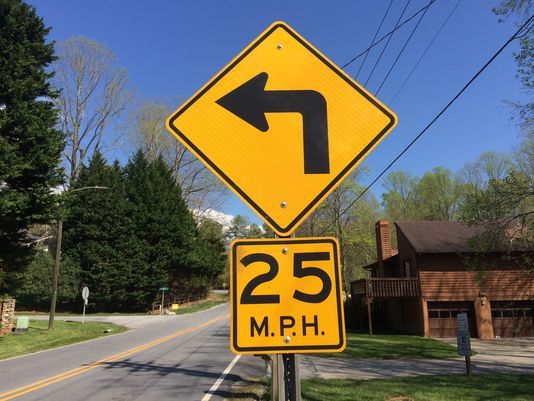Today’s batch of burning questions, my smart-aleck answers and the real deal:
Question: Driving down Fanning Bridge Road the other day, I noticed that on the curves they have yellow speed limit signs that indicate a curve is coming and say the speed limit is 25 mph. My son says these are not actual speed limit signs, but just a safe speed suggestion. The road had white speed limit signs with black lettering, and those say 35 mph. So, are the yellow signs just suggestions? Or are they actual speed limit signs that you can get a ticket for exceeding?
My answer: Wait a minute...you mean the white signs are not just suggestions?
Real answer: "They are just a cautionary speed," said North Carolina Highway Patrol Trooper Kelly Rhodes. "It means, 'This is the speed you can take this curve at safely,' but that is just a suggestion, believe it or not. They don’t have any kind of backing."
The signs have an actual name, and purpose.
"The yellow signs you are referring to are what the Manual on Uniform Traffic Control Devices call 'Horizontal Alignment Signs,' and the plaques posted below or on the Horizontal Alignment Signs are called 'Speed Advisories,'" said D. D. “Bucky” Galloway, the Western Region field operations engineer with the North Carolina Department of Transportation's Traffic Safety Unit. "These signs are solely used to advise motorists of a change in the roadway alignment and are not regulatory signs."
In short, the speeds are "the measured safe speed for a specific curve or a series of curves."
"In North Carolina, only black on white signs are considered regulatory and enforceable under general statutes," Galloway said.
Question: What ever happened to the snowy owl that ended up down here a few years ago? Is he still around the area?
My answer: Before I answer this question, may I ask how attached you were to said owl?
Real answer: "We lost the snowy owl," said Carlton Burke, at Carolina Mountain Naturalists in Mills River, which had rehabilitated the bird and taken it in. "It had a strange neurological disease that kind of popped up, and it went downhill over a period of several weeks. There was nothing we could do to save him."
Named "Tundra," the snowy owl died in July 2016.
The owl created a huge stir in the mountains and even the Southeast in late 2013 when it showed up on a farm in the Rosman area, starving and near death. A snowy owl had not been spotted in Western North Carolina for more than a century, with some reports putting the last encounter at 1891.
The birds, which have bright yellow eyes and a wingspan of five feet or so, are relatively plentiful in the far north, usually migrating to southern Canada or New England.
Burke said they had an extensive medical workup done on the bird, including X-rays, but none of the experts could figure out what was wrong with him. The disease mimicked a back injury, and steroid treatments were effective for a few days, but then the symptoms would recur.
When the bird showed up here, it was less than 6 months old, so Burke thinks it was 3-4 years at the time of death. In the wild, snowy owls live on average about 8-10 years, but the record for a bird in captivity is 28 years old, Burke said.
This is the opinion of John Boyle. Contact him at 232-5847 or jboyle@citizen-times.com


